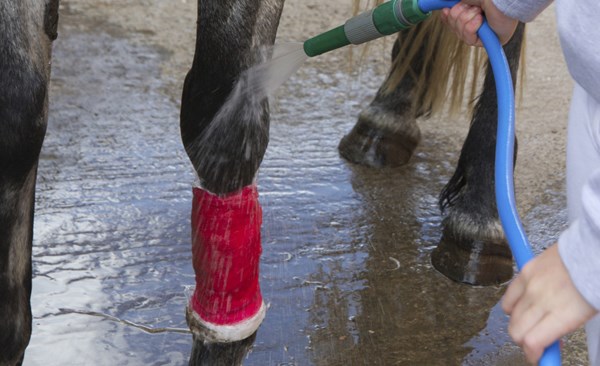 Credit: Thinkstock
Credit: ThinkstockBandaging limb wounds resulted in the formation of proud flesh. However, if the proud flesh was removed, bandaging (or not bandaging) had no effect on total time to healing.
Many horse owners fear limb injuries, not only because of potential lameness issues, but because of the intense care that usually accompanies them. Recently, two studies investigated the use of different ointments and/or bandaging strategies in wound healing and granulation tissue (i.e., proud flesh) formation in limbs.
Researchers in Virginia set out to determine whether povidone iodine ointment or two forms of silver sulfadiazine applied topically to wounds on horse limbs affected the rate healing and the influence of bandaging on proud flesh formation. Six healthy adult horses were used. Six standardized skin wounds per horse were distributed between the dorsomedial surfaces of the metacarpi and metatarsi. One of the following six treatments was applied to each wound: 1% silver sulfadiazine cream with bandage, 1% silver sulfadiazine slow-release matrix with bandage, 1% silver sulfadiazine slow-release matrix without bandage, povidone-iodine ointment with bandage, untreated control with bandage, and untreated control without bandage.
Wound area, proud flesh area, and perimeter were measured using digital images, and proud flesh was removed when present. Days until healing, rate of healing , rate of contraction, and epithelialization were compared among wound treatment groups.
Healing parameters did not differ among any of the wound treatment groups. All bandaged wounds produced proud flesh tissue, which was surgically removed; none of the unbandaged wounds produced proud flesh tissue. When the proud flesh tissue was removed, rates of healing were not different among wound treatment groups, whether bandaged or unbandaged.
In a separate study, researchers from Australia came to a similar conclusion. Their objective was to evaluate the effect of a non-occlusive dressing incorporated in a three-layer bandage on limb would healing. Seventeen horses were bandaged with a non-occlusive dressing covered by gauze-coated cotton wool that was compressed with adhesive tape, while 16 horses were left unbandaged. Standardized wounds were made on the skin overlying the dorsomedial aspect of the mid-metacarpus. Wounds were photographed weekly for nine weeks and the images were analyzed electronically.
There were significant effects associated with bandaging. In bandaged wounds, proud flesh tissue required regular trimming, but not in unbandaged wounds. There was no difference between groups in the total days to healing or the overall rate of healing. If excessive granulation tissue was excised regularly, bandaging had no effect on total time to healing.
Both studies concluded that bandaging limb wounds resulted in the formation of proud flesh. However, if the proud flesh was removed, bandaging (or not bandaging) had no effect on total time to healing.
Summarized by Krishona Martinson, PhD, University of Minnesota.


